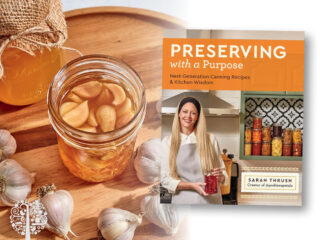An Exerpt from Preserving with a Purpose by Sarah Thrush

It’s the season for preserving our hard-earned harvests for year-round enjoyment, an art and a science I learned more about while interviewing Sarah Thrush, author of Preserving with a Purpose. Sarah is a total boss when it comes to canning and fermenting wholesome foods, and the following recipe appears in her fantastic guide. If you’ve got a massive haul of garlic this year, try making this delicious Honey-Fermented “100-Year Garlic”.
How to Make Honey-Fermented “100-Year Garlic”
I call this recipe “100-Year Garlic” because it can last hundreds of years. The tradition of fermenting garlic in honey dates back thousands of years, as ancient Egyptian tombs have revealed—a captivating narrative that transcends borders and cultures. But you don’t have to wait a century to enjoy this time-honored treat.
Makes approximately 1 pint (473 ml)

PER WIDE-MOUTH PINT JAR
20 to 30 peeled whole garlic cloves, approximately 1 cup (136 g)
1 cup (340 g) raw honey
- Place the peeled whole garlic cloves in a pint-sized, wide-mouth Mason jar, ensuring they are evenly distributed. To quick-peel garlic, place cloves in a microwave dish and microwave for 10 to 12 seconds. The garlic peels will slip right off.
- Pour enough raw honey into the jar to completely cover the garlic cloves. Ideally, you want the jar no more than two-thirds full, allowing air space for the garlic to bubble (ferment) in the honey.
- Place a canning lid and ring on the jar, leaving the ring loose. Place the jar on a countertop or shelf.
- Every couple of days for 2 to 4 weeks, unscrew the ring and “burp” the garlic to release the gases in the jar from the fermentation process.
- Tighten the ring securely, and flip the jar upside down to recoat the garlic cloves.
- When turning the jar upright again, loosen the ring before returning it to the counter or shelf.
- When the honey no longer contains gas bubbles (around 1 month), the garlic has finished fermenting and is ready to enjoy. The longer it sits on your shelves, the darker the garlic will become and the more infused the flavors.
- For long-term storage, keep the jar in a cool, dry environment away from direct sunlight. Enjoy for the next hundred years!
WHAT IS NORMAL DURING FERMENTATION?
✽ Bubbles in the honey. These are gases related to the fermentation process.
✽ Hissing or whooshing sounds when burping the jar every day.
✽ Honey becoming runny. Honey is hydrophilic and will draw the water from the garlic, thinning the honey.
✽ Garlic cloves with a bluish or greenish hue during fermentation. While this may look unusual, it’s not harmful and the honey garlic remains usable.
IMPORTANT THINGS TO KNOW ABOUT FERMANTATION
✽ It is crucial to use raw honey for this recipe, as it contains the necessary bacteria and wild yeast for fermentation. This recipe is unsafe to consume unless you use raw honey.
✽ Do not give any part of this recipe—honey or garlic—to infants or children under two years of age.
✽ Place a plate or napkin under the jar during fermentation. The mixture may bubble up as part of the process, causing some honey to drip out.
✽ To address concerns about botulism, use a pH test strip. Botulism spores cannot thrive in an environment with a pH below 4.6. Honey typically has a pH of around 3.9, though this can vary.
✽ Do not add more honey or garlic to the jar after fermentation. If you are running low, start a brand-new jar with new ingredients. Reusing honey can lower the pH to unsafe thresholds.
HOW TO USE FERMENTED GARLIC HONEY
✽ Straight from the jar. A teaspoon of garlic honey with one fermented clove is a wonderful treat, and it also has good medicinal properties. Take at the first sign of a cold or as a routine immune booster for health maintenance.
✽ In cooking. Use in condiments, salad dressings, fruit and pizza drizzle, and marinades.